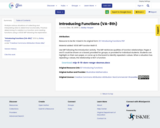
Describing and determining mean, median, mode, and range of a set of data - Mathematics Instructional Plan
- Subject:
- Mathematics
- Material Type:
- Lesson Plan
- Provider:
- VDOE
- Author:
- VDOE
- Date Added:
- 10/07/2024

Describing and determining mean, median, mode, and range of a set of data - Mathematics Instructional Plan

Relations and Functions: Domain and Range Mathematics Instructional Plan

Relations, Functions, Domain, and Range Algebra Readiness Remediation Plan

Functions, Domain and Range Algebra Readiness Formative Assessment

The Soccer Competition Task Template, Student Version of Task, Anchor Papers and Scoring Rationale

Introduction to Logarithmic Functions as Inverse of an Exponential - Mathematics Instructional Plan

Introduce quadratic functions and explore how domain and range are used to measure height and distance - Rich Mathematical Task Template, Student Version, Anchor Papers, and Scoring Rationale

Formative Assessment - Investigate and analyze function families - Just in Time Quick Check, Teacher Notes, and Supporting Resources

Student will:analyze a map of the Chesapeake Baycalculate the mean, median, mode, range, and numbercreate an appropriate graphinvestigate data provided by the James River and apply learning

This is a Desmos activity to explore domain and range of continuous functions. Students do not need prior knowledge of domain and range; this is an exploratory instructional activity.

Analyze various situations of collecting and interpreting data to determine functionality. Practice determining if a relation is a function and creating functions using a VDOE MIP following the exploration.

Just in Time Quick Check Range as a Measure of Spread

Just in Time Quick Check Determine Mean, Median, Mode, and Range

Just in Time Quick Check Domain and Range

Mic Drop Maths is a mathematics podcast for 5th graders based on the VA Standards of Learning. Each episode addresses one standard and is broken into segments including concept, real-world application, math history, literature connections, misconceptions, and more! There is music, sound effects, jokes, and student voice in each engaging and entertaining episode.

This video is part of the Continue to Know with WHRO TV series. Watch Kieasha King teach about rounding whole numbers expressed to the millions place.

This video is part of the Continue to Know with WHRO TV series. Watch Kieasha King teach about rounding whole numbers expressed to the millions place.